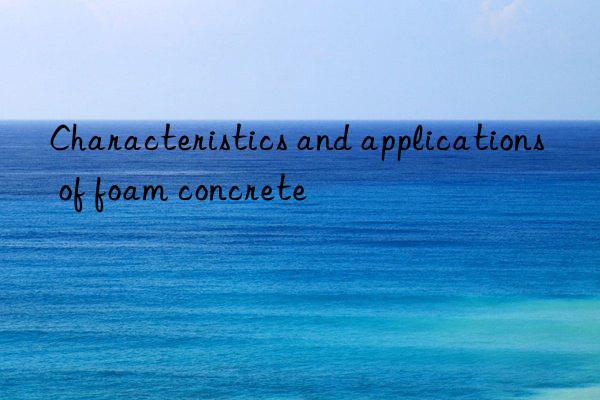
Foamed concrete, also known as foam concrete or lightweight concrete. The pumping system of the foaming machine performs cast-in-place construction or mold forming, and is formed by natural curing as a new lightweight insulation material containing a large number of closed pores; foamed concrete is made of foaming agent, cement, fly ash, and stone powder. It is a double set of continuous polymers that are mixed into organic cement and contains uniform pores; foamed concrete is an energy-saving material used for roof insulation and slope finding, ground insulation cushion, upturned beam foundation pit filling, wall pouring and other energy-saving materials.
Because foamed concrete contains a large number of closed pores, it has the following good physical and mechanical properties.
1. Lightweight
The density of foamed concrete is low, and the density grade is generally 300-1800kg/m3. The density grade of commonly used foamed concrete is 300-1200kg/m3. In recent years, ultra-light foam concrete with a density of 160 kg/m3 has also been used in construction projects. Due to the low density of foam concrete, the use of this material in internal and external walls, layers, floors, columns and other building structures of buildings can generally reduce the weight of the building by about 25%. For structural members, if foam concrete is used instead of ordinary concrete, the bearing capacity of the member can be improved.
2. Good thermal insulation performance
Because foamed concrete contains a large number of closed small pores, it has good thermal performance, that is, good thermal insulation performance. Generally, foamed concrete with a density level in the range of 300-1200 kg/m3 has a thermal conductivity between 0.08-0.3w/(m·K), and the thermal resistance is about 10-20 times that of ordinary concrete.
3. Good sound insulation and fire resistance
Foam concrete is a porous material, so it is also a good sound insulation material. This material can be used as a sound insulation layer on the top floors of buildings. Foam concrete is an inorganic material that does not burn and therefore has good fire resistance. When used in buildings, it can improve the fire resistance of buildings.
4. Low elasticity and good shock absorption
The porosity of foamed concrete gives it a low elastic modulus, so that it has good absorption and dispersion of impact loads. .
5. Strong waterproof performance
Cast-in-situ foamed concrete has low water absorption, relatively independent closed bubbles and good integrity, which makes it have certain waterproof properties.
6. Good durability
The same life span as the main project.
7. Convenient production and processing
Foamed concrete can not only be produced into a variety of products in the factory, but can also be constructed on site and directly poured into roofs, floors and wall.
8. Good environmental performance
The raw materials required for foamed concrete are cement and foaming agent. The foaming agent is neutral and does not contain harmful substances such as benzene and formaldehyde, which avoids Environmental pollution and fire hazards.
Scope of application
With its good characteristics, foam concrete is widely used in energy-saving wall materials and has also been used in other aspects. At present, the main applications of foam concrete in my country are cast-in-place foam concrete insulation layers for roofs, foam concrete face blocks, foam concrete lightweight wall panels, and foam concrete compensation foundations. However, by making full use of the good characteristics of foam concrete, its application scope in housing construction projects can be continuously expanded, the project progress can be accelerated, and the project quality can be improved. The details are as follows:
1. Make sandwich components. Foam concrete can be used as the inner core in prefabricated reinforced concrete components, which has good properties of light weight and high strength thermal insulation. Foam concrete with a density of 400 - 600kg/m3 is usually used.
2. Roof slope. Foam concrete is used for roof slopes and has the advantages of light weight, fast construction speed, and low price. The slope is generally 10mm/m. The thickness is 0.03-0.2m, and foam concrete with a density of 800-1200kg/m3 is used.
3. Others. Foam concrete can also be used for insulation filling of firewalls, sound insulation floor filling, tunnel liner backfilling, and isolation of power supply and water pipelines. </p



 微信扫一扫打赏
微信扫一扫打赏
